Glutathione Peroxidase Activity and Vitamin E Concentrations in Bearded Dragons, Pogona vitticeps
Nutritional deficiencies or imbalances are an unfortunate sequela to improper feeding and husbandry of exotic pets. The dietary requirements for many vitamins and minerals have not been established in captive reptiles. Clinical signs of limb paresis and ataxia unresponsive to vitamin D3 or calcium have been observed in bearded dragons, Pogona vitticeps, and some clinicians hypothesize that it may be caused by vitamin E-selenium deficiency. The purposes of this study were 1) to measure plasma vitamin E concentrations and erythrocyte glutathione peroxidase activity in bearded dragons eating different diets, and 2) to determine whether the paresis syndrome recognized in these animals is caused by vitamin E or selenium deficiency. Plasma α-tocopherol concentrations and erythrocyte glutathione peroxidase activity were measured in 34 healthy and one clinically affected captive bearded dragons. Mean concentrations for α-tocopherol (23.23 ± 18.63 μmol/L) and glutathione peroxidase activity (209.02 ± 72.63 U/g Hb) were established in this species. There were no significant differences in glutathione peroxidase activity or plasma α-tocopherol concentrations based on diet. Plasma vitamin E concentration of the clinically affected animal was higher than in healthy animals. However, this animal was receiving oral vitamin E supplementation for three months prior to this study. No significant correlation between α-tocopherol levels and glutathione peroxidase activity was observed. Although baseline data for establishing references ranges for vitamin E and glutathione peroxidase activity in this species were obtained, the pathogenesis of paresis/ataxia could not be determined.ABSTRACT



